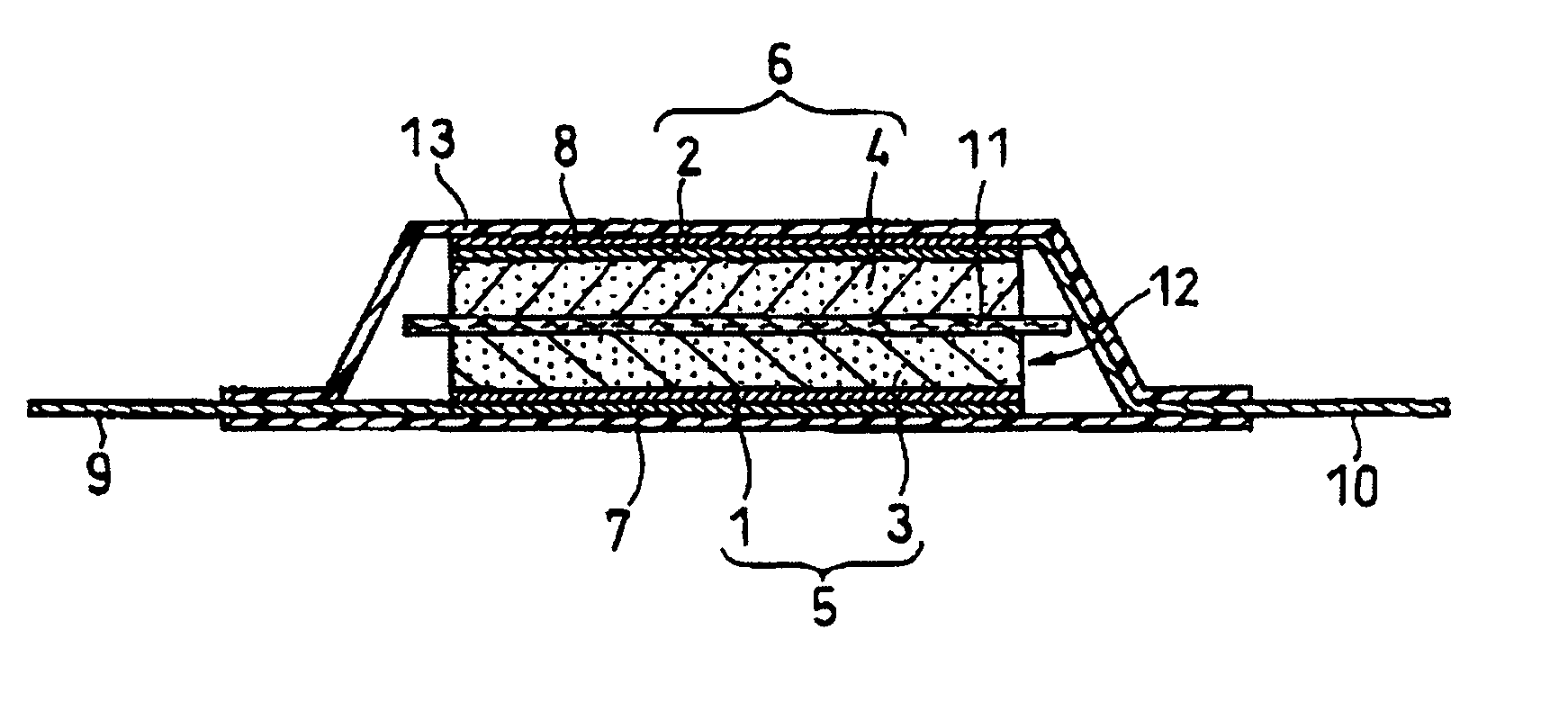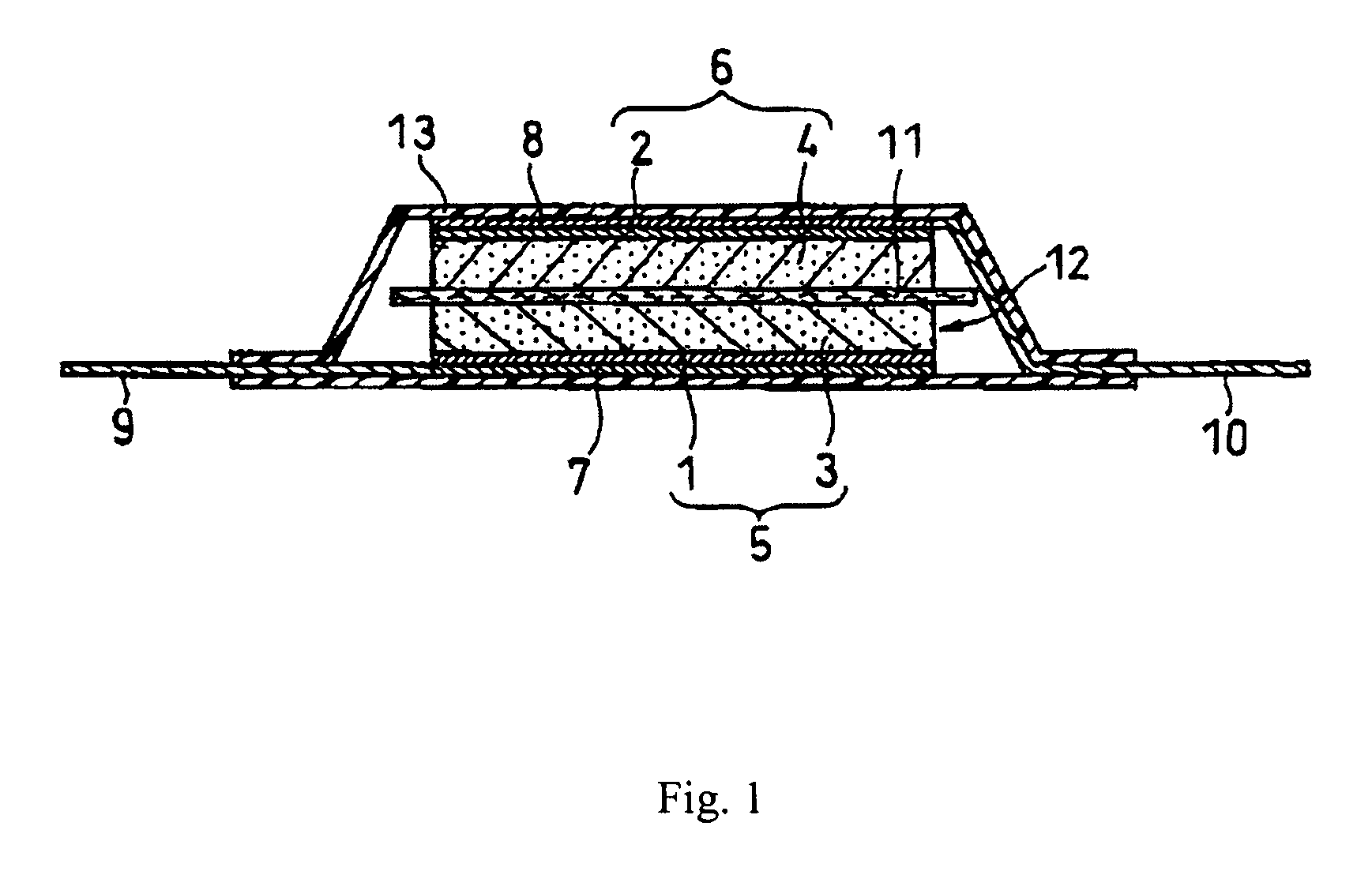Nonaqueous electrolyte for electrochemical devices
a technology of electrochemical devices and electrolyte, which is applied in the field of non-aqueous electrolyte, can solve the problems of increasing the internal resistance of the electric double-layer capacitor or the secondary battery, increasing the safety of the electric double-layer capacitor and the secondary battery, and reducing the viscosity of the electrolyte, so as to achieve high-quality electrochemical devices and suppress the effect of the viscosity ris
- Summary
- Abstract
- Description
- Claims
- Application Information
AI Technical Summary
Benefits of technology
Problems solved by technology
Method used
Image
Examples
example 1
[0027]An electric double-layer capacitor as shown in FIG. 1 was fabricated as follows. First, two active material layers 3, 4 were coated respectively onto aluminum foil current collectors 1, 2, and thus a pair of polarizable electrode plates 5, 6 were formed. A separator 11 made of polypropylene nonwovens was interposed between the two electrode plates 5, 6. Then aluminum collector plates 7, 8 were laminated with the aforesaid members being superimposed between them, so as to form a plate electrode assembly 12. Leads 9, 10 were welded to the collector plates 7, 8. The active material coating layers on the polarizable electrode plates 5, 6 face toward the separator 11. Two leads 9,10 were oriented towards opposite directions and the plate electrode assembly 12 was fixed with a tape (not shown in FIG. 1). Next, the plate electrode assembly 12 was accommodated in tube 13 made of a polypropylene laminate film including an aluminum foil therein. An opening of tube 13 through which lead ...
example 2
[0034]Electric double-layer capacitors were fabricated in the same manner as in Example 1, except that the nonaqueous electrolytes were prepared by mixing TMPA.TFSI as a room temperature molten salt and a fluorohydrocarbon selected from those described below in Table 2 at a molar ratio of 2:1.
[0035]The electric double-layer capacitors of Example 2 and Comparative Example 1 were charged at a temperature of 20° C. with an upper limit voltage of 2.5V and a constant current of 8 mA, then kept for 1 hour at a constant voltage of 2.5V, afterward discharged with a lower limit voltage of 0V and a constant current of 8 mA. Then the capacitors were charged again with an upper limit voltage of 2.5V and a constant current of 8 mA, and placed in a constant temperature chamber of −10° C. for one week, then the temperature was returned to 20° C., and the capacitors were discharged with a lower limit voltage of 0V and a constant current of 8 mA. The remaining capacities of the electric double-layer...
example 3
[0039]Electric double-layer capacitors were fabricated in the same manner as in Example 1, except that the nonaqueous electrolytes were prepared by mixing each of the room temperature molten salts described below in Table 3 and FB as a fluorohydrocarbon at a molar ratio of 2:1.
PUM
| Property | Measurement | Unit |
|---|---|---|
| temperature | aaaaa | aaaaa |
| temperature | aaaaa | aaaaa |
| constant current | aaaaa | aaaaa |
Abstract
Description
Claims
Application Information
 Login to View More
Login to View More - R&D
- Intellectual Property
- Life Sciences
- Materials
- Tech Scout
- Unparalleled Data Quality
- Higher Quality Content
- 60% Fewer Hallucinations
Browse by: Latest US Patents, China's latest patents, Technical Efficacy Thesaurus, Application Domain, Technology Topic, Popular Technical Reports.
© 2025 PatSnap. All rights reserved.Legal|Privacy policy|Modern Slavery Act Transparency Statement|Sitemap|About US| Contact US: help@patsnap.com


